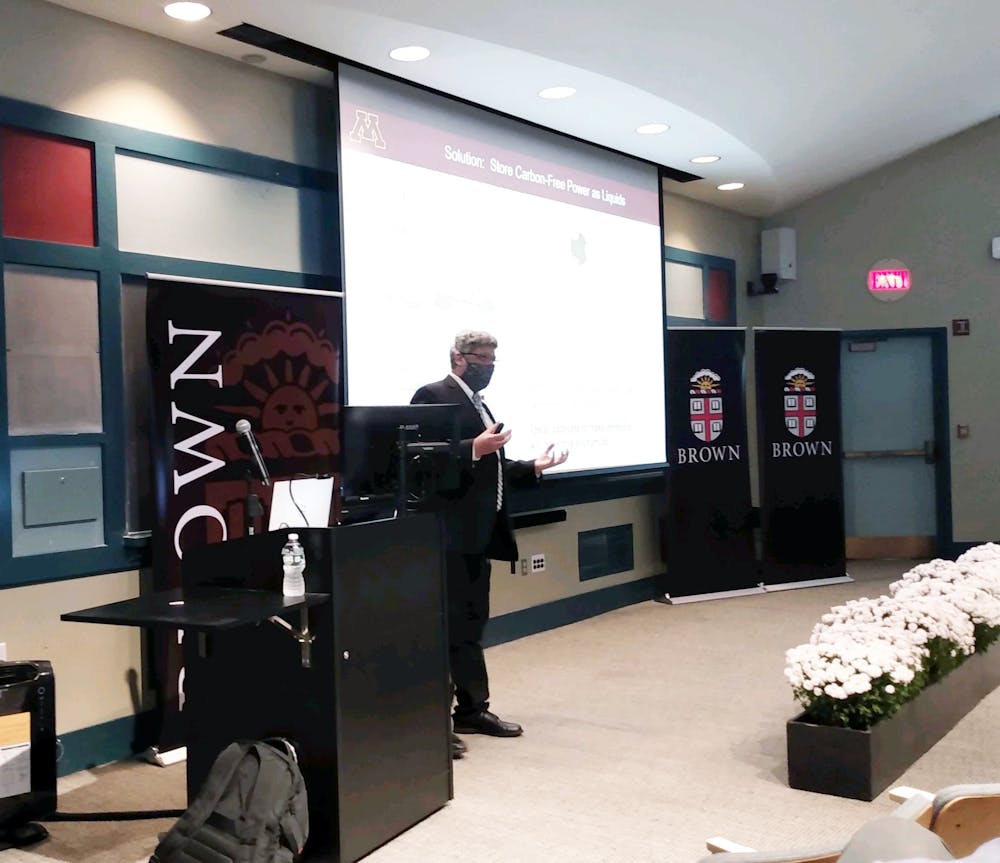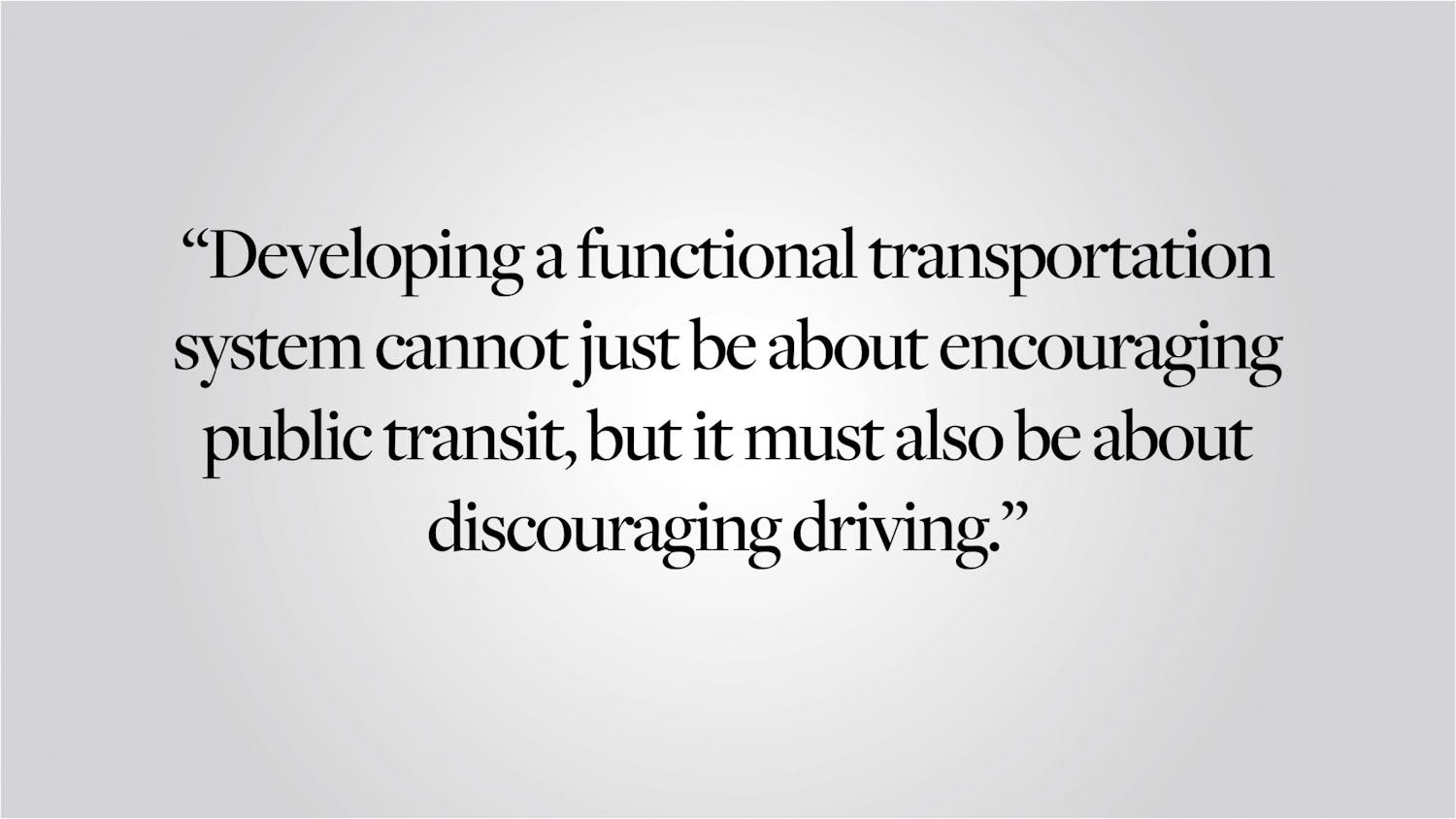“Technology has solved world-scale problems, existential problems,” University of Minnesota Chemical Engineering Professor and MacArthur Fellow Paul Dauenhauer said during a Monday evening lecture held in the Salomon Center. “And we’re on the verge of doing it again with energy.”
Dauenhauer’s lecture was part of the School of Engineering’s Dourdeville Lecture series, which annually invites a speaker to discuss issues at the intersection of engineering and societal improvement.
Dauenhauer shared his thoughts on technological solutions to a wide range of environmental problems at his talk entitled “Imagining a Fully Sustainable Carbon Future of Materials and Energy.” He discussed a number of potential engineering solutions to environmental issues such as storage and transport of wind and solar power, plastics recycling and the development of biorenewable plastics and rubbers.
Solving questions of producing, storing clean energy
Much of the lecture focused on the search for new ways to store wind and solar energy in ammonia, which would allow for a rapid, large-scale transition to clean energy, according to Dauenhauer.
The main factor holding back this transition, Dauenhauer explained, was the disconnect, both in time and space, between energy production and energy use. Solar energy can only be produced during the day, he said, and wind turbines operate best at night, meaning that it is difficult to make either a reliable source of energy for large populations. Many solar and wind farms are also located far away from population centers, making transport an issue. Additionally, energy use is much higher in the winter and summer than in other times of year, further increasing the need for effective storage.
What’s missing in the transition to a green energy economy, he said, “is the ability to take the power we produce and the power we use and store it, manage it, balance it, between when we use it and when we don’t use it.”
The solution he proposed involves using renewable energy at the site of a wind or solar farm to produce ammonia. This is a chemical compound that can be easily liquefied and transported by trucks, ships or pipelines to wherever it is needed. When burned, ammonia only releases nitrogen gas and water, making energy production an extremely low-carbon process, from generation to usage, he said.
“We could do things like manufacture ammonia in Australia and put it on a ship outside of Mumbai or near Beijing — places where a lot of people live… and pump it in as we need it,” he said.
The problem, he said, was the lack of an efficient catalyst to allow the ammonia-creating reaction to happen. “We haven’t made (the reaction) any faster,” he said.
Currently, he said, the lack of efficiency in the process is preventing this method from effectively competing with fossil fuels in the energy market.
The potential remedy that he is studying, he added, involves technology known as a catalytic pump, which can catalyze a reaction 1,000 to 10,000 times faster and use less energy than the typical method of producing ammonia.
“We’re already working on these things,” Dauenhauer said, pointing to a picture of a University of Minnesota solar farm being used to test different technologies to increase the efficiency of ammonia production. “These are real possibilities for the future.”
Creating more biorenewable products
Dauenhauer also talked about new applications of chemical engineering in creating ecologically sustainable products from plastics to rubbers to detergents. Many plastic products, he said, can now be created from biorenewable biomass sources — such as agricultural waste — instead of from petroleum.
“I know I can compete with petroleum using biomass as our starting material,” he said, but currently, the challenge is to make the processes more efficient and cost-effective.
But, Dauenhauer said, “biorenewable is not enough,” because the problem of waste still remains. He noted that a common problem with many biorenewable materials is that some are not recyclable and even if they are, the quality worsens after recycling.
As a result, his team and others have come up with a number of new biodegradable or recyclable products. He said that advances in chemical engineering now allow for recycled products to retain quality in a way they hadn’t been able to before, which creates the potential for a closed-loop economy based upon continuously recycling plastic products.
For Dauenhauer’s new products, such as biodegradable rubber, one would “never know if it’s recycled or not,” he said. “The performance will be identical.”
He noted that this sustainable technology is already being implemented, pointing to a number of start-up companies founded by University of Minnesota researchers. “This is really happening now, and it’s not just (my) little start-up companies,” he said. “It’s big companies, medium size companies, all around the world, seeing the potential that your trash could have value.”
These advances in recycling, he speculated, could someday lead to a world in which trash becomes a valuable commodity rather than something that is discarded.
Engineering solutions to societal threats
Throughout the lecture and in an interview with The Herald, Dauenhauer expressed a strong belief in technology’s capacity to solve pressing issues impacting society.
Technological advances have helped to solve looming societal issues in the past, he said, and they will be able to do so again. He pointed to a widespread concern at the beginning of the 20th century that soil depletion would soon lead the world to run dangerously low on food, evidenced by an 1898 speech at the British Academy of Sciences that predicted mass death beginning in the 1930s. This crisis, he said, was averted with the creation of the Haber-Bosch process, which allowed for the mass production of fertilizer that sparked the Green Revolution.
The rapidly increasing efficiency of solar and wind energy, he said in an interview with The Herald, is more evidence of the power of engineering. “What’s amazing to me,” he said, “is that when I was 15, people said solar and wind technology (would) never work — not that they (wouldn’t) function, but that they (would) never be cost effective.”
“It felt sort of hopeless,” he said in the lecture.
“Right now we can make solar panel arrays and wind turbine sets that are cheaper than the cheapest fossil fuels. That’s astounding,” he told The Herald. “And it happened very quickly — in the last 10 years.”
Technological advances, he said, may be able to help compensate for the difficulty in passing climate change policy. For instance, although a carbon tax would incentivize decarbonization, he said policy is “difficult to enact.”
This would also present “issues of fairness (for) countries that use less energy compared to countries like America that are more developed.”
Instead, Dauenhauer added, “we can create new technologies that are carbon free, that will let us solve these problems … We could invent a technology that solves our problems.”





